Matthew S. Williams's Blog, page 206
June 7, 2012
“Bath Salts” and the Zombie Apocalypse
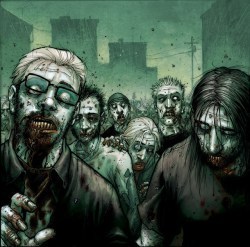 I hear it more and more these days: “Is this the Zombie Apocalypse we were warned about?” Or is this just one of those rare occasions when pop culture and real news come together to create a sick, existential joke? In either case, I think we all know what I’m talking about. A little incident involving a naked man and some face eating? Yes, that one!
I hear it more and more these days: “Is this the Zombie Apocalypse we were warned about?” Or is this just one of those rare occasions when pop culture and real news come together to create a sick, existential joke? In either case, I think we all know what I’m talking about. A little incident involving a naked man and some face eating? Yes, that one!
In that case, police indicated that drugs were involved, a strange new psychogenic named “Cloud Nine”. This drug is apparently a form of MDPV cocaine, also known by the street name “Bath Salts”. The “zombie man” Rudy Eugene was apparently loaded on the euphoric amphetamine when he attacked Ronald Poppo, bit half his face off, and then threatened to eat the police.
 According to numerous stories on the subject, this product is a perfectly legal form of bath salt that is meant to provide an invigorating bath experience. But given its recent link to this and other incidents , that’s likely to change! Shortly after the first “zombie attack” took place, police in Miami began reporting similar incidents where people ere either biting or threatening to bite other passerby’s. Here too, the behavior was attributed to Bath Salts.
According to numerous stories on the subject, this product is a perfectly legal form of bath salt that is meant to provide an invigorating bath experience. But given its recent link to this and other incidents , that’s likely to change! Shortly after the first “zombie attack” took place, police in Miami began reporting similar incidents where people ere either biting or threatening to bite other passerby’s. Here too, the behavior was attributed to Bath Salts.
And now it seems that a similar incident has happened here in the Great White North. For those not familiar with the Luke Magnotta story, allow me to elaborate. It began a few days ago when two political party headquarters in Montreal began receiving body parts in the mail. This was followed shortly thereafter by more body parts appearing on the doorstep of Vancouver Police Department, which appeared to belong to the same victim.

Magnotta, crazy-ass freak!
It took no time at all for authorities to identify the guilty party, a 29 year old man by the name of Luke Magnotta who was apparently a gay porn actor. After committing the grisly crime, he had fled to Germany where authorities found him and arrested him. According to the police reports, he was in an internet cafe reading about himself online. It also took them no time to identify the victim, a Chinese student named Lin Jun, a 33 year old man who was having a relationship with Magnotta.

RIP dude!
Based on their initial investigation, police revealed that in addition to cutting his former lover up, Magnotta also engaged in some cannibalism with the body parts and video-taped the whole thing. He posted these and other gruesome tidbits on the web, hence why it was not hard to catch him! He is being extradited as we speak to Canada to stand trial. No indication has been given yet whether or not Bath Salts or some other drug was involved, or if he was just bat-shit crazy.
Granted, this is not the first time that drugs have been linked to cannibalistic behavior. In fact, cases have been reported where people high on PCP/”Angel Dust” have engaged in these and other totally messed-up behaviors. Still, the way this has coincided with the recent zombie craze is nothing short of sickening and frightening!
Just in case, I think it might be a good idea to start researching Zombie guns. I’m not condoning the whole “Zombie Apocalypse” theory, I’m just saying that it might not be a bad idea to have a contingency plan just in case this behavior starts to… you know, spread! In the meantime, I’m thinking it might not be too late to re-evaluate the “Just Say No” policy either, especially where Bath Salts are concerned. I know we all love a good, invigorating bath, but it aint worth becoming a zombie people! Stick to aromatherapy, lotions and luffa; or better yet, do what I do and just have a hot shower. Thanks for listening, and in the meantime, protect your exposed flesh!








Wired Tribute to Ray Bradbury
 Here we see Bradbury seated in the NASA control center back in the 1960′s. Apparently, it was his contention, prior to the Moon Landing, that the United States was headed for spiritual ruin unless “dumb politicians” got out of the way and let Americans reach for the stars. Well, he certainly got his wish, didn’t he?
Here we see Bradbury seated in the NASA control center back in the 1960′s. Apparently, it was his contention, prior to the Moon Landing, that the United States was headed for spiritual ruin unless “dumb politicians” got out of the way and let Americans reach for the stars. Well, he certainly got his wish, didn’t he?
Unfortunately, this science fiction great did not live long enough to see the colonization of Mars, which was a recurring theme of his writing. But given the current state of the world economy and the space race, I wonder if any of us will.
But I didn’t start this post to be gloomy. Mainly I want to share an article which I came across today from Wired magazine. It contains Bradbury’s thoughts on a multiplicity of subjects, as expressed in his most famous quotes. It was a lucky coincidence that I found it, since my wife shared one of his oft-quoted lines with me once I told her the sad news.
Riding home in the car together, she turned to me and said: “You must stay drunk on writing so reality cannot destroy you.” Since she’s always encouraged my writing, I couldn’t help but feel that she thought I could draw some inspiration from this. Mission accomplished.
These and other quotes can be found in the article, just click on the link below. And remember, you got any cool thoughts, be sure to write them down. You never know, someday, somebody could be quoting you!
http://www.wired.com/underwire/2012/06/ray-bradbury-big-ideas/








The Revelation Space Universe
 Lighthuggers, Inhibitors, Ultras, Hyperpigs, Conjoiners Drives, Demarchists, Chasm City… Few science fiction authors have come up with as many weird and intriguing concepts as Alastair Reynolds. The author of the Revelation Space series, Pushing Ice, Blue Remembered Earth, Century Rain, House of Suns, Terminal World, and a slew of short stories and articles, Reynolds is not only a hard science fiction author but an actual scientist.
Lighthuggers, Inhibitors, Ultras, Hyperpigs, Conjoiners Drives, Demarchists, Chasm City… Few science fiction authors have come up with as many weird and intriguing concepts as Alastair Reynolds. The author of the Revelation Space series, Pushing Ice, Blue Remembered Earth, Century Rain, House of Suns, Terminal World, and a slew of short stories and articles, Reynolds is not only a hard science fiction author but an actual scientist.
Yes, from 1991 to 2004, Reynolds worked as an astronomer for the European Space Research and Technology Center, which is part of the European Space Agency, in Noordwijk, Holland. So when it comes to matters of science and space – be it exploration, travel, or the physics thereof – this guy really knows what he’s talking about.
To start my review of his work off right, I’d like to cover his first full-length novel. Known as Revelation Space, this story became the basis for the universe of the same name and the setting of most of his books. It also advanced a lot of ideas and concepts which would inspire yours truly 
Revelation Space (2000): The story opens with three separate but interrelated strands, though their connection is initially unclear. The first takes place on a planet known as Resurgam in 2551, where an archaeologist named Dr. Dan Sylveste is leading an expedition to uncover the remains of the Amarantin. This alien species, which were a winged-humoid race, existed for over 900,000 years on the planet before some cataclysmic event wiped them out.
The story opens with three separate but interrelated strands, though their connection is initially unclear. The first takes place on a planet known as Resurgam in 2551, where an archaeologist named Dr. Dan Sylveste is leading an expedition to uncover the remains of the Amarantin. This alien species, which were a winged-humoid race, existed for over 900,000 years on the planet before some cataclysmic event wiped them out.
The most recent discovery of the excavation team proves that the Amarantin were far more technologically developed than previously thought. Retiring to his den, Dan begins to commune with the beta-level simulation of his deceased father, Calvin Sylveste. Often, he consults his father, who died on Yellowstone, for advice in matters scientific and political. However, Dan soon learns that coup has taken place due to his obsession with uncovering the Amarantin, and a party shows up at the site to arrest him.
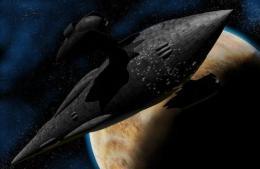 Cut to 2540 aboard the Nostalgia for Infinity, a “Lighthugger” vessel that is the mainstay of the universe in this time (the name refers to the fact that it can fly to within an inch of the speed of light.) Here,Triumvir Ilia Volyova is awake while the other crew members are in reefersleep (cryogenic suspension). They are en route to the Epsilon Eridani system and the planet of Yellowstone to find Dan Sylveste, not knowing that he departed for Resurgam some 15 years previously.
Cut to 2540 aboard the Nostalgia for Infinity, a “Lighthugger” vessel that is the mainstay of the universe in this time (the name refers to the fact that it can fly to within an inch of the speed of light.) Here,Triumvir Ilia Volyova is awake while the other crew members are in reefersleep (cryogenic suspension). They are en route to the Epsilon Eridani system and the planet of Yellowstone to find Dan Sylveste, not knowing that he departed for Resurgam some 15 years previously.
Its crew of Ultras (modified spacers) is desperate to find Sylveste since their Captain is a victim of the Melding Plague – a nanovirus that has infected all of Yellowstone. Basically, they are seeking his services yet again since his last treatment did not seem to take. Ilia also plans to pick up a new gunner since their last one apparently went insane and had to be spaced, the only clue he left behind was the name “Sun Stealer”, which he wrote on a wall in his own blood.
 Last, the scene switches to 2524 and the surface of Yellowstone, where professional assassin Ana Khouri is hired by a wealthy recluse known as The Mademoiselle. Apparently, she wants Dan Sylveste found and killed, and she knows the Nostalgia for Infinity will go to the ends of the universe to find him. As such, she orders Khouri to go into stasis and meet up with the crew 20 years later when they arrive in orbit.
Last, the scene switches to 2524 and the surface of Yellowstone, where professional assassin Ana Khouri is hired by a wealthy recluse known as The Mademoiselle. Apparently, she wants Dan Sylveste found and killed, and she knows the Nostalgia for Infinity will go to the ends of the universe to find him. As such, she orders Khouri to go into stasis and meet up with the crew 20 years later when they arrive in orbit.
Meanwhile, we learn a few things of importance. For one, the Nostalgia appears to have been infected by virus other than the one that’s got their Captain in cryo-sleep. This virus appears to be what drove the last gunner insane and is threatening to kill Ilia now. During a training exercise where they test their landing suits, another glitch results in the death of another crewman, leaving only the Triumvirs – Ilia, Hegazi, Sajake – and the Captain.
We also learn that the cargo hold of the ship is holding a large supply of Cache Weapons, what are apparently referred to as Hell-class, all of which appear to be a bunch of Doomsday devices. Ilia secured these weapons from sources unknown, but in time it is suggested that they are of Conjoiner manufacture – the same advanced faction that built the Nostalgia’s engines (aka. Conjoiner Drives).
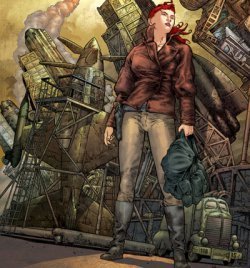
Artist concept of Ana Khouri
And finally, we learn why Sylveste is on Resurgam and why the Mademoiselle wants him dead. As it turns out, the Sylveste family maintained a research institute on Yellowstone dedicated to the study of alien civilizations. Many extinct cultures were discovered by humanity as it spread into space, no living ones aside from two exceptions. The first were the Pattern Jugglers, a planet-wide sentient species that comprised massive kelp nets that seemed to preserve the neural patterns of anyone who walked into them. The second were known as the Shrouders, aliens that were presumed to exist within a bunch of anomalous space-time bubbles.
Sylveste became interested in these when a colleague of his became the first to survive contact with a “Shroud” but was left insane. After years of doing nothing but scrawl images on the floor, he spoke and told Sylveste that he actually made contact with an alien intelligence inside the Shroud. This area of space-time, he said, was known as “Revelation Space”. He told him further that they held information about a great mystery that would explain the deaths of all alien civilizations in the quadrant, and that he had to go to the Jugglers to get it. As preservers of memories, they held the secrets of many dead alien worlds in their massive neural nets.
 Having completed all this, Sylveste finally flew into the Shroud and survived. However, his partner in the expedition, a female researcher, was lost and presumed dead. In truth, she survived, but just barely, and returned to Yellowstone where she became a recluse known as… wait for it… the Mademoiselle! Hence why she wants Sylveste dead, because she blames him for her accident and the fact that she is now forced to live in a containment apparatus.
Having completed all this, Sylveste finally flew into the Shroud and survived. However, his partner in the expedition, a female researcher, was lost and presumed dead. In truth, she survived, but just barely, and returned to Yellowstone where she became a recluse known as… wait for it… the Mademoiselle! Hence why she wants Sylveste dead, because she blames him for her accident and the fact that she is now forced to live in a containment apparatus.
Ah but there’s more! After he made contact with “Revelation Space”, Sylveste was told to go to Resurgam where he would find his answers. He did not know why, but it seemed the Amarantin were the final piece of the puzzle. Before that happened though, he was brought aboard the Nostalgia to help the Captain for the first time. And years later, his work would be interrupted when the colony rose up against him.
Hints are also given as to what is going on vis a vis the extinction and the virus aboard the Nostalgia. Essentially, eons and eons ago, the first intelligent races of the Galaxy met up and began a prolonged conflict known as the Dawn War. After millions of years of fighting, the remaining civilizations, exhausted and cynical about sentient life, combined their intelligences with machinery to create a series of specialized weapons. Collectively, they came to be known as the Inhibitors, a race of machine-like intelligences that sought out sentient life and exterminated it once it achieved a high level of technical development.
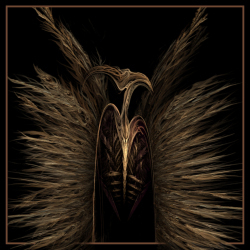
Sun Stealer by bartolomeusz
Meanwhile, on Resurgam, Sylveste is given a reprieve from house arrest to see the latest results of the excavation, which have proceeded in his absence. It seems that the crews turned up a massive underground city containing many ruins, and hints as to what happened. Featured over and over are an Amarantin idol which is reaching towards the sun. Hints are also given that Resurgam’s moon, Cerberus, was also particularly significant to the Amarantin people. After learning of all this, Sylveste proposes marriage to his new sweatheart and they prepare to have their marriage in the city ruins.
By 2566, Khouri is brought aboard as the ships new gunner and they arrive at Resurgam. However, before they make orbit, a nearly catastrophic situation occurs when one of the ship’s doomsday weapons suddenly becomes active and has to be released. It detonates off their bow and creates an artificial singularity which very nearly consumes their ship. Having just made it away, Ilia concludes that the virus is stepping up its game!
Once they make orbit, the crew establishes contact and demands Sylveste be turned over. To make their point, they stage a ruse where they pretend to level an outlying settlement, and the colony responds by handing Sylveste over. This they do by attacking him during his wedding and taking him and his wife prisoner. The crew fly down in their special suits to retrieve him and announce that they plan to bring him and his wife aboard. However, Sylveste turns the tables by saying his artificial eyes contain a pinhead antimatter device that will destroy their ship. He lists new terms, which include letting his wife go and taking him to Resurgam’s moon of Cerberus. In exchange, he promises to help their Captain any way he can.
As Sylveste and the crew of the Nostalgia for Infinity approach Cerberus, Sylveste realizes the massive celestial body isn’t a planet at all—but rather, a massive space station. They fly inside and begin to be set upon by the devices defenses, but eventually make it down inside. Once in there, Sylveste realizes what it really is. Basically, the moon was built eons ago by the Inhibitors which served as a beacon to alert them of the emergence of a star faring intelligence. Once activated, it would signal the Inhibitors to launch their machines to the system so they could exterminate whichever species found them. Sylveste concludes that this is what happened to the Amarantin.
Aboard the Nostalgia, Ilia also is confronted by the truth when the virus threatens to finally take over the ship. Appearing on the ships main display, an Amarantin who identifies himself as “Sun Stealer” explains their purpose to her. Apparently, the Amarantin are the Shrouders! These bubbles in space time have been their protection against the Inhibitors for hundreds of thousands of years, and their means of drawing out new sentient races to find them and do their bidding. When Sylveste’s colleague passed into them, they realized their time had come, and as such, tried to manipulate him into discovering if the Inhibitors were still alive out there.
Unfortunately, this case of first contact went poorly. Not being able to recognize his neural patterns, the Amarantin nearly drove Sylveste’s friend completely mad with their message. Luckily for them, he was able to make sense of it in time and delivered it to Sylveste, who then came back to the Shroud where they were able to imprint a series of clues in his mind as well as a virus that would monitor him. These, they hoped would eventually lead him back to their homeworld and the moon of Cerebrus. Their intent all along was to have someone else make contact with the Inhibitor machine, thus they could see if it was safe to emerge from hiding. If so, they planned to retake their homeworld. If not, it would be a different race who was exterminated and they would wait until the next came along.
However, that plan changed when Sylveste came aboard the Nostalgia for the first time and unknowingly planted the virus in the ship’s hardware. Hence why the gunner went mad and why its been threatening to take over the ship. Cut off from Sylveste, it was beginning to go mad. However, once he was aboard, it saw an opportunity to complete its mission. Having taken the helm, Sun Stealer now kept the ship in orbit around the moon and began reporting everything it saw back to the Amarantin Shroud.
Down on the station, Sylveste realizes that the beacon has become active and that he has been played. Rather than allow the Inhibitors to emerge, he detonates the bombs in his eyes to destroy the facility. Back on the ship, Ilia decides to unleash the Melding Plague that’s been consuming their Captain and let Sun Stealer do battle with it. Sun Stealer loses and the ship begins transforming into a gothic nightmarish version of itself. But at least they’ve restored control of it to themselves. The story ends with the crew reuniting and setting course for Resurgam again.
Good Points and Bad:
Well, I don’t know if you could tell from my description, but the plot of this book was pretty damn complicated and mighty layered. And personally, I thought that was a good thing! It is not unusual for an author to have distinct points of view in a story that seem unrelated but inevitably come together, but Reynolds was really working overtime with this one. How and where the plots overlapped could produce headaches due to the sheer effort of keeping track of it all, but I for one felt it worked pretty well.
In addition, the inventions and futuristic concepts were a real mind-blower for me at the time. In fact, I specifically picked up this book in order to research modern sci-fi and get a dose of the latest hard science, and that’s exactly what I got. Beta-level simulations, Alpha constructs, nanotechnology, servitors, Lighthuggers, inertia, controlled singularities, and the like. It all called to mind numerous other classic sci-fi franchises, many of which Reynolds himself acknowledged a debt to.
For example, his Inhibitors sounded very much like the Firstborn of the Space Odyssey series. Here and there, you had aliens who were so advanced that they could download their consciousness into machinery that would preserve them for eternity, making for effective space travel in a universe that didn’t permit FTL. Reefersleep also called to mind cryogenic pods from Alien and other franchises. Cybernetic implants, augmentation and nanobots are all concepts one can find elsewhere too. Still, the way Reynolds combined these things together was quite masterful, and very much in keeping with the tradition of space opera.
And finally, I found the story downright intriguing. The concept of an ancient race that prevents the rise of space-faring sentient life because it knows from experience that such life will likely engage in prolonged war with other sentients seemed quite believable. One need only look at the process of human history to know that conflict is a defining feature, and that peace on a grand scale only seems to follow in the wake of terrible, exhausting wars. Consider Europe after two world wars, Japan after the Shogunate wars, or China after its Warring States period (and even after that!) Like it or not, peace and consensus are very often the result of war, war, and more war.
Okay, now for the weak stuff. As I said already, the plot can be convoluted. For the most part, this works in the story’s favor. However, something which comes up in other Reynold’s works as well, is his tendency to throw in too many plot twists, especially towards the end. Already we have a very complicated and layered story which really didn’t need any more curve balls, but some are thrown even as the other plot threads are culminating. In this story, the unnecessary twists involve last-minute revelations.
In Sylveste’s case, this happens just before he is captured by his own people and he takes the opportunity to unburden himself to his wife. He tells her that his father once had an alpha-level simulation of himself, as opposed to the beta that he frequently talks to. He gave this alpha to the Pattern Jugglers in exchange for the info they gave him. It is also revealed that Dan Sylveste is in fact a clone of his father. Hence his vanity and obsessive nature, they were retained from a father who wanted a duplicate of himself.
Last, there’s the revelation that the Captain of Nostalgia – John Brannigan – went into the Jugglers sea himself and used them to imprint his mind on Sajaki, one of the Triumvirs. His reasons had to do with the fact that he knew he needed to go into reefersleep until they found a cure for the Melding Plague. Unable to stand the idea of being out of it for so long, he decided to get the Jugglers to erase Sajaki’s mind and replace it with a copy of his own, that way he could be aware of everything that was going on while he was under. This twist seemed quite unnecessary too, as it really didn’t advance the plot any, just added another complication.
But overall, I was very pleased with this book and was sure to pick up its sequel. In fact, Revelation Space was the second Reynold’s book I had read at this point (the first was Century Rain) and I consider his writing to be a highly educational experience. In fact, much of his ideas and hard scientific basis served to inspire my own writing, particularly when it came to Source. So when it comes to authors I owe a debt to, he’s right up there! Stay tuned for more reviews of Reynolds and the Revelation Space Universe!








June 6, 2012
Ray Bradbury (1920 – 2012)

Ray Douglas Bradbury (August 22, 1920 – June 5, 2012)
Yesterday, one of the greatest sci-fi minds of the 20th center, Ray Bradbury, died at the age of 91 after a lengthy illness. His publisher, HarperCollins, were apparently the ones to break the news to the world. Best known for his seminal dystopian novel Fahrenheit 451, Bradbury quickly joined the ranks of authors like Orwell, Huxley, Clarke, and Asimov, in that he was a speculative author who’s predictions rapidly came true.
Amongst such things were the emergence of ATMs, wall-sized televisions, interactive entertainment, and live broadcasts of fugitive car chases. In addition to Fahrenheit 451, he also penned the Martian Chronicles, The Illustrated Man, and Something Wicked this Way Comes, and over 600 other works of fiction, articles and essays. As such, his influence and legacy are truly immeasurable.
So, in honor of this sci-fi great, whom I waited a very long time to read, I shall delve into his best known works and try to explain exactly why they were so enduring and influential. Let’s start with the book that earned him his reputation in the first place:
Fahrenheit 451 (1953):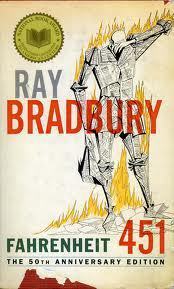 This dystopian piece of speculative fiction takes place in the late 20th century, when American culture has degenerated into a form of brutal escapism. Nuclear war looms on the horizon, books have been banned, and for the majority of people, cocooning in their homes in front of their wall-sized monitors seems like the perfect distraction.
This dystopian piece of speculative fiction takes place in the late 20th century, when American culture has degenerated into a form of brutal escapism. Nuclear war looms on the horizon, books have been banned, and for the majority of people, cocooning in their homes in front of their wall-sized monitors seems like the perfect distraction.
The story takes place from the point of view of a Fireman named Guy Montag, who’s job consists of located offenders and burning their books. This is the role of firemen in the future, who instead of fighting fires are responsible for starting them. Montag is unhappy with his life and suffering from a deep sense of disquiet.
Until one night when a young woman named Clarisse shakes up his worldview. Whereas most people in Montag’s world seemed numbed and dead, she is vital and alive, and questions just about everything. Shortly thereafter, she dies in a tragic accident, which shakes Montag’s world up even more.
He too begins questioning the rules, he steals books from jobs he is meant to pull, and begins reading them. Realizing he is now in violation of the law, he seeks out other offenders for answers. This brings him into contact with Faber, a former English professor that Montag knows can help. In time, Faber is convinced to bring him into this confidence and reveals that he is part of a circle that is dedicated to the preservation of written knowledge.
Eventually, Montag is found out and must flee. His boss, it seems, has known for quite for some time what he is up to but extended him some courtesy because he knows what he’s going through. More enlightened than the average person, Montag’s boss explains to him why books have been banned and why they must destroy them. Rather than the result of forced censorship, the process was entirely voluntary. People chose mindless entertainment, distraction and fast cars over reading, reflection and learning.
Montag’s escape from his house and the police becomes the subject of the evening news. He manages to elude the authorities and meets up with the reading circle down by the river. Interestingly enough, he flees the city just in time to witness being destroyed from a nuclear attack. It seems the build-up to Armageddon has finally ended and nuclear war has come. Montag leaves with the group, who’s mission now has become one of preserving civilization as well as literature.
What was enduringly brilliant about this book was not so much the predictions about technology or the emergence of book banning, but the reasons for it. Capturing the zeitgeist of his age, Bradbury essentially felt that a shocked and fearful society would seek escape by the most convenient means available to them. And whereas most dystopian novels involve ignorance and illiteracy being forced by a brutal regime, Bradbury believed that the process would be entirely voluntary. In this respect, he captured the same essence as Huxley, another dystopian critic who believed man’s appetite for distraction would be it’s undoing.
The Martian Chronicles (1950): Though written before Fahrenheit 451, the MC gained notoriety more slowly, but eventually became recognized as one of the great works of science fiction. A collection of loosely based stories rather than a single novel, the book follows the future history of colonization on Mars, dealing with all kinds of speculative, existential and scientific questions.
Though written before Fahrenheit 451, the MC gained notoriety more slowly, but eventually became recognized as one of the great works of science fiction. A collection of loosely based stories rather than a single novel, the book follows the future history of colonization on Mars, dealing with all kinds of speculative, existential and scientific questions.
The overall structure of the book comes in three parts, punctuated by two catastrophes. The first is the near-extinction of the Martians, while the second is the parallel near-extinction of the human race. In first part of the book takes place at the end of the 20th century and details mankind’s efforts to reach Mars, and the various ways in which the Martian natives keep them from returning. However, towards the end (in the story “—And the Moon be Still as Bright”) it is revealed the majority of the Martians have died as a result of a plague brought from Earth.
This opens Act II, taking place in the early 21st century, where humans begin colonizing the Red Planet. On occasion, they have the opportunity to make contact with the surviving Martians, but mainly are concerned with building a second Earth. However, many settlers begin to pack up and leave as looming nuclear war on Earth causes them to want to get back and be with their families. The outbreak of this war signals the end of Act II and the opening of the third act.
In the third and final act of the book, all contact has been lost with Earth when the nuclear war takes place. As the war passes, those humans who have survived on Mars have began building a distinct civilization and having children who have only known life on the Red Planet, effectively becoming Martian themselves. This prospect allows the book to return to its beginning, as it is suggested that new waves of colonists will soon be coming and conflicts are likely to emerge as a result.
This book was not only brilliant in that it addressed a great deal of scientific and existential questions that are sure to come when actual colonization begins (if ever). It also managed to capture a sense of timeless truth and lessons which come from real history, or the “Age of Discovery” as its known. These included the destruction of native inhabitants, the push-pull factors which lead to colonization, severance from the homeland, and eventual adaptation as new people begin to embrace the new environment as their home.
Much like KSR’s Mars Series, this book should be required reading if ever any Ares missions get underway!
The Illustrated Man (1951):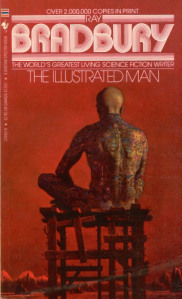 Much like the Martian Chronicles, this book is a collection of short stories linked by a common theme. Through its exploration of humankind, the recurring theme is one of conflict between cold mechanics and technology and the basic nature of human beings. Many of these stories have been adapted into film over the years and been used in schools as educational tools. Some examples include:
Much like the Martian Chronicles, this book is a collection of short stories linked by a common theme. Through its exploration of humankind, the recurring theme is one of conflict between cold mechanics and technology and the basic nature of human beings. Many of these stories have been adapted into film over the years and been used in schools as educational tools. Some examples include:
“The Veldt” – in this story, we see a family who’s children have become terribly attached to the houses’ high tech nursery. Like a holodeck from Star Trek, the children use this to create virtual environments – in this case, the predatory environment of the African veldt. When the parents threaten to take it away, the children lock them inside and they are apparently consumed by the lions. thought it is not outright said, it is implied that the children have reprogrammed the unit to become real and have been “feeding” people to it for some time.
“The Other Foot” – in this exercise in turnabout, we learn that Mars has been colonized solely by people of African descent. When they learn that a rocket is coming from Earth with white travelers, they decide to institute a system of racial segregation similar to that of the Jim Crow Laws of the American South, in retaliation for the wrongs of history. However, when the rocket lands the traveler tells them that most of the Earth has been destroyed in a nuclear war and the people realize that discrimination is harmful in all its forms. They rescind their discriminatory laws and welcome the new crew as equals.
“The Man” – A group of space explorers land on a planet to find the population living in a healthy state of bliss. Upon investigation, they discover that an enigmatic visitor came to them, who they eventually conclude was Jesus (or some other religious persona since He was never named). Some decide to spend the rest of their days rejoicing with the natives, while another decides to continue on in his spaceship in the hopes of catching up with this person. While he spends the rest of his days in hot pursuit, always one step behind and never quite catching up to him, the other learn that “he” is still on the planet with them. Hello metaphor!
“The Exiles” – taking a page (no pun!) from Fahrenheit 451, this story revolves around the concept of burning books and the immeasurable nature of knowledge being lost forever. It begins with stating that numerous works of literature have been banned and burned on Earth. The fictional characters of these books are portrayed as real-life entities who live in a refuge on Mars. These characters are vulnerable however since once all the books on a character are destroyed, that character vanishes permanently. When the group of characters learn that some people are coming for them, they stage a counterattack, but are foiled by the astronauts who burn the last remaining books from Earth, unknowingly annihilating the entire colony.
“Marionettes, Inc.” – A man attempts to escape his marriage by replacing himself with a robot to fool his wife into thinking he hasn’t left and tells a friend about it. The man comes back and tells the robot to go back into the box, and the robot disobeys him saying he has fallen in love with the wife. The robot then proceeds to put the man in the box and replaces him for real. Sound familiar?
“The Illustrated Man” - The namesake of the book, this story involves an overweight carnival worker is given a second chance as a Tattooed Man, and visits a strange woman who applies skin illustrations over his entire body. She covers two special areas, claiming they will show the future. When the first is revealed, it’s an illustration of the man strangling his wife. Shortly after this comes to pass, the carnival workers run the man down, beat him, and look at the second area, which shows an illustration of the same beating they are doing. Can you say self-fulfilling prophecy?
Most of these stories would probably sound familiar in one way or anther, but that’s because they’ve been adapted, copied and referenced by countless pop culture sources. I myself recall watching “The Veldt” in school and being chilled by its eerie and dystopian tone. “Marionettes Inc.” has been adapted into comedy format numerous times, and the theme of prophecy and fulfillment in “The Illustrated Man” has inspired countless stories, not the least of which are The Butterfly Effect and perhaps even PKD’s Minority Report.
Something Wicked This Way Comes (1962):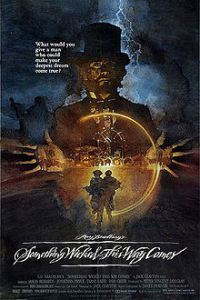 A somewhat off-beat work for Bradbury, who’s works consist mainly of speculative sci-fi, this fantasy/horror novel has nevertheless become a household name for fans of the dark and weird. Set in modern a day Midwestern town, the story revolves around a visiting carnival and its mysterious director, Mr. Black.
A somewhat off-beat work for Bradbury, who’s works consist mainly of speculative sci-fi, this fantasy/horror novel has nevertheless become a household name for fans of the dark and weird. Set in modern a day Midwestern town, the story revolves around a visiting carnival and its mysterious director, Mr. Black.
Enter into this the story’s protagonists, two 13 year old boys, Jim Nightshade and William Halloway, who witness the arrival of the carnival and become immediately enthralled with it. They quickly realize that everyone who works there has been lured into Mr. Dark’s service through the promise of being able to live out their fantasies. For most people, these involve become younger, a gift he confers on several characters through his “magic” carousel.
In time, they come to realize that Mr. Dark holds these people under his sway and has a tatoo of each of them on his body, a symbol of his control. Charles Holloway, William’s father, looks into Mr. Dark’s past and realizes he can be defeated through love. It is unclear what this entails, but after the boy’s are kidnapped, he comes to the carnival and begins destroying it’s structures and Dark’s protectors by expressing laughter and joy. He and his son use the same tactic to eventually bring down Mr. Dark and bring Jim back from death, who was stuck on the carousel and rapidly aging.
Though different from most of his other works in terms of genre, this story did contain many elements which were present in his other stories. For example, the concept of the carnival and the tattooed man was the basis of “The Illustrated Man”. The nostalgic feel of the story was also to be found in his novel Dandelion Wine, and is often paired with this novel as presenting both the lighter and darker sides of childhood. And of course, the novels resolution, where good prevails through purity of heart, is to be found in many of Bradbury’s works.
Because of its focus on good versus evil, childhood, and coming of age, this story was to have a profound effect on several authors, the most notable of which is Stephen King. Citing Something Wicked as his inspiration, King attributed a debt to Bradbury for helping to write It and Dreamcatcher.
Final Thoughts:
In the end, Bradbury was known for many things: originality, depth, vision and genius. But the thing that sticks with the most about him was his views on the preciousness of literature and knowledge. Basically, he expressed several times over how when something is lost, it’s lost forever. I can only assume then that he would take great comfort in knowing that he left the literary legacy that he did. Though he may no longer be with us, his works will live on and serve to inspire many generations to come.
I think this is a lesson we could all draw from. Though our time on this Earth may be short, we have the ability to leave our mark and ensure that some trace of us stays behind. So make those footprints people, write those manuscripts, and most importantly, tell the people you love how you feel. Do not leave things unsaid or undone, because someday, we will be gone…
Rest In Peace Mr. Bradbury. You did it right, and now you go on to join the other greats of your time!








June 5, 2012
More Prometheus Trailers: Quiet Eye and Space Travel Part I
So… here we find ourselves just two days shy of the official release date of the movie Prometheus. And wouldn’t you know it, these people still aren’t finished toying with us yet! Seems they got more trailers, which I just happened to snag! Let’s be honest, sci-fi and Aliens fans everywhere are hungry as hell at this point, and these are just more tiny snacks to tease us with! But what can we do? Any snippets that come out, we gotta gobble em up! So here they are… Bon appetit!
The first video is entitled “Quiet Eye”, where an interview camera takes archeologist Dr. Elizabeth Shaw’s statement to Mr. Weyland (head of Weyland Industies). Basically, she is stating why she should be allowed to lead the Prometheus mission and speaks about its potential benefits to the company. You know, Alien-type stuff!

Second, there is this clip I dug up over at Verizon’s Facebook page (they are apparently a big sponsor. This particular one is an interview with Prometheus’ conceptual artists who talk about the eponymously named ship, its design and layout, and how all of this was intrinsic to setting the tone and feel of the movie.

Jeez… When is this damn movie coming out?!








Once in a lifetime view of Venus
 There are stellar events which take place once in a lifetime. The arrival of Haley’s Comet, the alignment of three or more planets, and as of yesterday, the passage of Venus across the face of the Sun. According to astronomers, this event will not happen for another 105 years. So for those of us who lucky enough to see it, this really is a once in a lifetime event
There are stellar events which take place once in a lifetime. The arrival of Haley’s Comet, the alignment of three or more planets, and as of yesterday, the passage of Venus across the face of the Sun. According to astronomers, this event will not happen for another 105 years. So for those of us who lucky enough to see it, this really is a once in a lifetime event
News of this has junior astronomers scrambling to get a glimpse, and the web is already buzzing from the first photos to be uploaded. The one featured at top comes from the orbiting satellite known as the Solar Dynamics Observatory, courtesy of NASA, and is the first views of Venus passing in front of the Sun’s Corona. The second, featured below, is from the same satellite and is a close up of the planet as it begins to move across the face of the sun. 
But by far the most impressive images come from NASA live’s feed which captured Venus’ early passage from the depths of space into the Sun’s corona. Captured with a AIA 171 wavelength channel (that’s 171 angstrom, extreme ultraviolet) one thing which really stands out are the coronal loops. These are the extended arcs which reach up from the surface of the Sun, where plasma moves along magnetic field lines. The brightest visible spots are the locations where the magnetic field s exceptionally strong near the surface.

This second video comes from NASA’s ESA SOHO spacecraft, which tracked the planets approach before SDO took over and began tracking it across the Sun. Images and feeds are still coming in and can be expected to do for some time. For those people in Hawaii, Alaska and South Korea, the view of the passage is expected to be ideal since it will coincide with their daylight hours. Those of us on this side of the world will just have to be content with what we can catch! I recommend everyone get out back with some protective eyewear – don’t stare directly into the Sun! – and see what they can see. Once in a lifetime people!









Thanks Twitterers!
I recently noticed that some of my buds here have been sharing my articles over on Twitter quite regularly. I can only assume that they did this out of sheer awesomeness, and that in doing so they sent some more traffic my way. As such, I want to thank those responsible. So thank you to the following people (and their twitter handles):
Cassie Hynds (@CassieHynds) – erotic fiction writer and critic who frequently includes me in her “awesome author” posts. Don’t know what she sees in my humble sci-fi blog, but who am I to complain?
Goran Zidar (@GZidar) – my colleague over at Grim5Next and a fellow writer. His YA, paranormal works can also be found on Story Time.me, which by the way he is the creator of!
Vanessa Howe (@geekinacardigan) – fellow geek, sci-fi enthusiast, and Firefly acolyte who seems to appreciate this stuff even more than I do. Didn’t think that was possible, but again, can’t complain! Good to have such people in my corner.
khaalidah (@khaalidah) – mother, wife, and fellow writer and colleague over at Grim5Next who’s cross cultural insights and personal touch with her writing puts me in awe. As a working mother, she often asks other writers where we find the time. Me? I wonder how SHE finds the time to produce these gems!
Nina D’Arcangela (@Sotet_Angyal) – a horror writer and the woman behind Siren’s Call Publications, she’s also a colleague over Grim5Next, not to mention the woman who beta’d my contribution to our anthology. She’s a talent scout people, put in a good word for me!
Maureen Hovermale (@zencherry) – writer, reviewer, voracious reader, this woman does it all and has the scars (and writer’s callouses, apparently) to prove it! I hope to keep garnering her attention, she sounds like she could worth impressing!
An extra shout out to all those who have given me any kind of promotion or reblogged me over the last two years. You’re a cornerstone of the edifice known as DIY writing! I hope I can return the favor someday. Like my pa always says, “It’s takes about 20 years to become an overnight success.” So my philosophy is, any breaks we can give each other are golden! So thank you all for and good luck in all your endeavors!








The Future is Here: Invisible Tanks!

Swedish-made CV90 with ADAPTIV panels
So far, we’ve heard of stealth fighters, stealth ships, and stealth suits. But what about stealth tanks? Why shouldn’t the mobile armored fighting vehicle be included in this race to make all weapons stealthy? Well its seems BAE (British Aerospace Marconi Electronic) Systems has decided to do just that. Working with the concept of Infra-Red imaging and its use on the modern battlefield, BAE has created the ADAPTIV camoflage system.
 Basically, modern military vehicles use IR imaging for a number of purposes, namely target acquisition, night vision, homing and tracking. Ever since the late 80s and early 90s, any vehicle that did not have these capabilities found themselves at a marked disadvantage on the battlefield. After all, if you can see your enemy but they can’t see you, then you can destroy them with impunity!
Basically, modern military vehicles use IR imaging for a number of purposes, namely target acquisition, night vision, homing and tracking. Ever since the late 80s and early 90s, any vehicle that did not have these capabilities found themselves at a marked disadvantage on the battlefield. After all, if you can see your enemy but they can’t see you, then you can destroy them with impunity!
A prime example of this happened during the Gulf War, where Iraqi armored formations were eviscerated simply they did not have the ability to see in the dark. While they moved about blind, US Abrams tanks simply targeted the enemy using their night vision and began picking them off one by one.
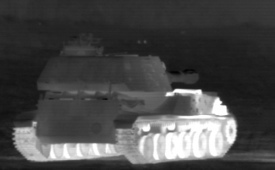 However, with every advanced army in the world employing IR technology, the pendulum has once again swung to defense. With all armies able to see an enemy vehicle’s thermal signature, any vehicle that has a way to hide it will now have the edge. That is the principle of ADAPTIV, which combines the idea of Infra-red concealment with the larger concept of adaptive camouflage.
However, with every advanced army in the world employing IR technology, the pendulum has once again swung to defense. With all armies able to see an enemy vehicle’s thermal signature, any vehicle that has a way to hide it will now have the edge. That is the principle of ADAPTIV, which combines the idea of Infra-red concealment with the larger concept of adaptive camouflage.
Essentially, this consists of sheets of hexagonal panels that act as pixels when attached to the exterior of the vehicle. These pixels can individually change temperature very rapidly and combine to display an infrared image of the background scenery captured from cameras on board the vehicle, allowing even a moving tank to match its surroundings. BAE has also put together a library of images to display the heat signature of other vehicles, such as cars, trucks, and natural objects, such as large rocks.
Pretty cool huh? Already the technology has been proposed as being adaptable to more than just land vehicles. It can also be added to helicopters, surface ships, for commercial use, and can even send friendly identification signals. Check out the BAE promotional video below for a demonstration.
[image error]








Dark Knight Parody
Hey all, I thought I’d share this little nuggat, the “The Dark Knight is Confused” by professional spoofsters The Key of Awesome. This is an oldie, but given all the Batman news of late, I thought it might be fun to post.
If you haven’t seen it yet, you really need to! Few people like to acknowledge that the Dark Knight had some serious plot holes, but these guys manage to make fun of them in just the right way. And the Joker and Alfred impersonations are pretty spot on. Click on it!









Game of Thrones, Season 2 Finale!
 Well it’s come at last. The big second season finale, the wrap up after the siege of King’s Landing, and the cliffhanger ending north of the Wall. And to be honest, I think this was the first episode I truly enjoyed. Not saying the other’s weren’t enjoyable as all hell. It’s just that with this episode, I found that I was finally putting aside the critical, comparative eye and just watching the show. Too bad too. But I guess I’ll have all summer to enjoy the re-runs. In the meantime, here’s what I thought about the season finale!
Well it’s come at last. The big second season finale, the wrap up after the siege of King’s Landing, and the cliffhanger ending north of the Wall. And to be honest, I think this was the first episode I truly enjoyed. Not saying the other’s weren’t enjoyable as all hell. It’s just that with this episode, I found that I was finally putting aside the critical, comparative eye and just watching the show. Too bad too. But I guess I’ll have all summer to enjoy the re-runs. In the meantime, here’s what I thought about the season finale!
Valar Morghulis: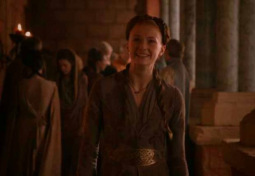 The mood is festive in King’s Landing, at least for most. Having secured the city from Stannis’ attack, Tywin Lannister and Ser Loras Tyrell are hailed as heroes. To cement the victory and the newfound alliance between House Lannister and House Tyrell, Joffrey agrees to marry Margaery Tyrell, rendering his marriage to Sansa null and void. Sansa is overjoyed, but must keep that herself. She is approached by Lord Pyter Baelish, who says he can smuggle her out of the capitol and bring her home.
The mood is festive in King’s Landing, at least for most. Having secured the city from Stannis’ attack, Tywin Lannister and Ser Loras Tyrell are hailed as heroes. To cement the victory and the newfound alliance between House Lannister and House Tyrell, Joffrey agrees to marry Margaery Tyrell, rendering his marriage to Sansa null and void. Sansa is overjoyed, but must keep that herself. She is approached by Lord Pyter Baelish, who says he can smuggle her out of the capitol and bring her home.
Meanwhile, Tyrion wakes up in his new room to find that he’s been stripped of his duties as Hand of the King. His father has taken that role, and his Tyrion’s loyal followers have all been paid off and sent away. He is alone and virtually friendless, but luckily, he still has Shae and the allegiance of Varys, who appears to be hatching his own schemes with Ros, the lady of the night who works in Baelish’s brother. Robb announces his nuptials with Talisa, much to the chagrin of his mother. She warns him that Walder Frey is not a man to be crossed, but he is insistent that he proceed with his marriage as planned.
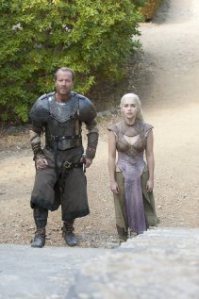 At Qarth, Daenerys enters the House of the Undying where she is confronted by the mages. Her dragons have been put in chains and so is she. However, her little scaled offspring begin belching fire at the mages and shattering their chains once they are reunited with her, and she quickly escapes with them in tow. Returning to Xaro’s house, Dany and her kin throw him into his chamber, which appears to be empty after all, and loot his house of anything of value. They proceed to the docks to buy what ships they can.
At Qarth, Daenerys enters the House of the Undying where she is confronted by the mages. Her dragons have been put in chains and so is she. However, her little scaled offspring begin belching fire at the mages and shattering their chains once they are reunited with her, and she quickly escapes with them in tow. Returning to Xaro’s house, Dany and her kin throw him into his chamber, which appears to be empty after all, and loot his house of anything of value. They proceed to the docks to buy what ships they can.
To the north, Theon is betrayed by his bannermen who kill him and set Winterfell ablaze. Brann, Rickson, Hodor and Osha leave the safety of the catacombs and begin heading north to the Wall where they believe they will be safe. Arya meanwhile meets up with Jaqen who is on his way back to Bravos. He invites her to come, but she says she must head north to her home. He gives her a coin and the words “Valar Morghulis” and tells her that they will buy her way to Bravos should she change her mind. He changes his face and bids her farewell.
 And beyond the Wall, John and Qorin finally have at it and John manages to kill him. This moves earns him the Wildlings trust, and it appears that was what Qorin had in mind all along. He is taken to the Wildlings encampment in a frozen valley where he sees tents as far as the eye can see. And lastly, the Night’s Watch at the First of the First Men are best by White Walkers. Emerging from the snow and ice, they come in droves and shriek out a terrible, bone chilling war cry!
And beyond the Wall, John and Qorin finally have at it and John manages to kill him. This moves earns him the Wildlings trust, and it appears that was what Qorin had in mind all along. He is taken to the Wildlings encampment in a frozen valley where he sees tents as far as the eye can see. And lastly, the Night’s Watch at the First of the First Men are best by White Walkers. Emerging from the snow and ice, they come in droves and shriek out a terrible, bone chilling war cry!
Final Thoughts on the Finale:
Well, once again I have to say that the did a very good job of adapting the novel to the screen. The ending was bone chilling and a real cliff-hanger,and they managed to do a good job of wrapping up all the seasons threads. When season 3 comes around, they will be in perfect firing position to pick the story up and take it even further towards resolution. Of course, changes were made again, but I have to say that with one exception, I was unanimously in favor of them this time around.
But before I get into that, I need to mention one change from the previous episodes that I totally forgot to mention. In episode 8, Arya and her pals make their escape thanks to Jaqen’s help. However, how they went about doing this was quite different than from in the book. There, Arya told Jaqen that she would un-utter his name if he freed the dungeons of all the Stark captives so they could take Harrenhal from the Lannisters. Since this would be done when Lord Tywin and the bulk of his army was away, there would not be enough men to defend against all the freed prisoners.
The plan worked, and Lord Bolton took command of the castle in the name of the Starks. However, that didn’t change Arya’s fortunes much, as she no one believed she was the Stark girl and she remained cupbearer, only this time to Lord Bolton. Jaqen had left at this point, giving her the coin and instructions on how to get to Bravos, so she had to free herself. She did this by killing a guard in the night and escaping with Gendry and Hot Pie, sans any help.
Of course, I could see why they simplified all this by having Jaqen simply kill the guards and letting her go free. It was a convoluted plot thread that took way longer in the book to resolve itself. And the same is true in this episode where we see both Theon’s betrayal and Sansa’s planned escape from King’s Landing being truncated. In the book, Theon was betrayed by one of his own, yes, but it was far more complicated. Essentially, Lord Bolton’s bastard was one of the men Theon freed from Winterfell’s dungeons, unbeknownst to him.
When he found that no help was coming from his father, he sent several men out to look for helpers. The bastard Bolton rode home, where he raised an army of his father’s men and returned just as Robb’s bannermen were outside the city. His forces set upon them and defeated them, and then were welcomed into Winterfell by Theon as liberators. However, the bastard of Bolton then killed Theon and ordered Winterfell razed, out of spite for how they put him in prison.
Complicated huh? Far better to just have Theon betrayed by his own men who then chose to raze the city and make a run for it, since it was obvious to them that no help was coming. And of course, Sansa’s planned escape from King’s Landing was more – you guessed it – complicated in the book. Here, it was Ser Dontos, the disgraced drunkard who’s life she saves at Joffrey’s tournament, offers to help free her during Joffrey’s wedding to Margaery Tyrell. In time (spoiler alert) she learns that he is being helped by Lord Pyter Baelish who is once again motivated to help her because of the love he has for her mother.
But once again, to simplify this and cut down on the necessary screen time, they leave out all of her secret meetings with Ser Dontas and speed ahead to Baelish simply telling her, “I can get you out”. Personally, I would have liked a secret deal being struck early on much better. The conspiratorial nature of it, as she was forced to endure Joffrey’s beatings and the queen’s abusive nature, was much more intriguing. Finding out that Pyter was involved was a good revelation too, which was effective since it was saved for the last minute.
Last, but not least, there was the changed nature of John’s “defection” and his fight with Qorin. Already they changed things, as I said in my previous posts, John and Qorin were taken prisoner together after he set Ygritte go. There was no prolonged scene between John and Ygritte in the wilderness with her trying to temp him with her Wildling wiles (ha!). But alas, they seemed to tie that up when it was revealed that both he and Qorin were taken and Qorin wanted him to make up for his failure.
And it was clear that Qorin was executing that plan when he attacked John Snow, baited him to anger, and then let him win their fight. But he did all that without explaining what he wanted John to do. This is something that they will be forced to answer for in season 3. Either John will decide to play the role of defector merely to stay alive, or he will be genuinely torn between his genuine affections for Ygritte and his duty to the Night’s Watch.
Oh yeah, and that added plot thread involving Ros and now Varys. Not sure what they’ve got planned there, all I can tell you is it never happened in the book. In fact, as I’ve pointed out numerous times now, nothing involving Ros happened in book II. Much like Dany’s attendant, Doreah, they seem to be inflating her role and keeping her alive a lot longer than in the book. But I assume there is a reason for it. After all, Doreah’s character very quickly dies in book II, and the way they kept her around was ultimately better in the series. I can only assume her plot with Varys will connect back to actual material from the book and wrap up nicely in the end.
But that’s another season and another series of posts! Right now, all I want to think about was that ending. White Walker everywhere, blue-eyed zombies taking to the frozen field, ready to lay down a hurting. And of course, that war cry at the end and the way the camera pans out to show just how many of them there are… Spine-tingly-dingly!
Thoughts on the Season:
Overall, I’m pretty pleased with what they did with this book and can see the logic in all the changes they made. I also liked how they brought back Jason Momoa to reprise his role as Khal Drogo, even if it was short lived. Seeing him portray the burley, tough, and yet gentle leader of the Dothraki was one of the highlights of season one. Even though I couldn’t stand the re-imagined Conan movie, or perhaps because of that, it was good to see him back in this role again.
And let’s not forget, the seige of King’s Landing, the climax of book II, was a real highlight for this season. Beautifully rendered, well-executed and choreographed, and ultimately very faithful to the book. In all adaptations, the writers and designers have their work cut out for them, but these guys have managed to pull it all off with limited resources. But then again, dedication and a great cast can do that! I can honestly say that despite all the wonderful costumes, settings and storyline, the biggest selling point of this show is the acting. George RR Martin is quite the writer, but the cast has always managed to deliver.
Well, that’s it for season two. Now begins the winter of our viewing discontent, otherwise known as summer reruns! See you next season with G-O-T… Season 3 (rhymes!), otherwise known as A Storm of Swords. It’s sure to be a blockbuster!












